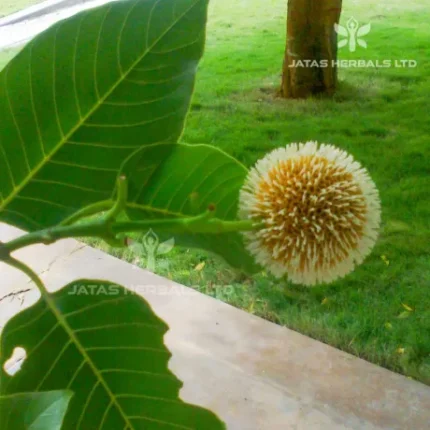Haritaki is one of the important as well as commonest herbs used by folk, house hold and traditional medicine. Its fruit rind is used in medicine and is one of the ingredients in TriphalŒ (three myrobalans). It is mainly indicated for constipation, respiratory problems, certain skin disorders, eye diseases etc. Caraka high-lighted its Rasayana properties in CikitsŒ sthŒna. He specifically stated Haritaki as best among the herbs to be used regularly. Sivadatta described Haritaki plant by making simile with Vasa leaves.
Though there is no controversy in the identity of its botanical source (T.chebula), in South India it is being adulterated with T. pallida while in Bengal and Assam another species T. citrina Roxb. Is being used as a variety of Haritaki. Kaiyadeva quoted three varieties viz., Niraja, Vanaja and Parvatiya. Bhavamisra on the otherhand, described seven varieties of haritaki viz., vijaya, rohini, putana, amrta, abhaya, jivanti and cetaki.
Botanical Description– It is a large tree, with rust-coloured or silvery hairs over the younger branchlets etc. Leaves– mostly subopposite, distant, ovate or oblong-ovate, 8-20 cm. long, deciduous in the cold season. Flowers– dull-white or yellowish, with a strong offensive smell, in spikes from the upper axils and in small terminal panicles. Fruits-obovoid or ellipsoidal from a broad base, glabrous, more or less 5-ribbed when dry. (Flowers in April-May and fruits in November-January). Distribution – Abundant in Northern India, also occurs in Bihar, West Bengal, Assam, Central India and South India.
Major chemical constituents–
Fruits- anthraquinone glycoside, chebulinic acid, tannic acid, terchebin, vit. C.
Fruit kernel- arachidic, behenic, lindeic, oleic, palmitic & stearic acids.
Flowers- Chebulin
Part Used– Fruit rind
Dosage– Powder 3-6 g.
Research works–
(1) Study of in vitro antibacterial activity of extracts from the plants of T. chebula. E. alba and O. sanctum was carried out by the disk diffusion technique. All showed such activity against human pathogenic Gram positive and Gram negative bacteria. The activity against Salmonella organisms was shown only by T. chebula; against Shigella organisms by T. chebula and E. alba, but not by O. sanctum. The widest spectrum of antibacterial activity was shown by T. chebula. It was also most potent (Sjuata & Kulkarni, 1989).
(2) Various extracts prepared from the powdered fruits have been wide antibacterial and antifungal spectrum (Inamdar et al., 1959).
(3) It also inhibits growth of E. coli, the most common organism responsible for urinary tract infection (Singh R.H. et al; 1974, and Meera et al., 1999).
(4) The oil in th ekernal increased the motility of GIT of the mouse. The action was comparable with castor oil. The oil by itself is non-irritant but releases an irritant principle when incubated with lipase (Miglani et al., 1971).
(5) LD50 of chebulin was 550 mg/kg in mice. IT exhibited antispasmodic action on smooth muscle similar to that of papaverine (J.Sci.Ind. as. 1962, 21C. 345)
(6) Ether extract showed higher antioxidant activity than BHA and BHT. Acid esters present in phenolic fraction of extract were found most effective (Chem. Abstr. 1993, 119, 269367c.)
(7) T. chebula fruit extracts inhibited ATPase activity in the cardiae muscle of frog in a dose-dependent manner (Azeem et al., 1990 & 1992).
(8) Various extracts prepared from the fruit rind of T-chebula have shown cardiotonic activity when tested on normal as well as hypodynamic isolated frog hearts. The extracts increased the force of contraction and cardiac output without altering the heart rate (Reddy et al., 1990).
(9) 46 children with diarrhoea wee given T. chebula and T. vulgare decoction. 57.17% children were cured within 3 days of treatment (Sharma et al., 1984).
(10) T. chebula is found to possess hypoglycaemic activity on glucose-induced hyperglycaemia in rats (Tripathi at al., 1979).
(11) The laxative property of T. chebula is studied in one of the clinical studies. Symptoms other then defication, evacuation and consistency were improved with T. Chebula fruit powder (6 gm) given after meals for seven days. Total response of the drug was excellent in 20% cases and good in 80% cases of simple constipation. No side effects reported (Tripathi et al., 1983).
(12) Antioxidant property of T. chebula is reported. Alcoholic extract 10-20 fg/ml markedly inhibited lipid peroxidation of mouse liver and lung homogenate and mitochondria. The above extracts effectively scavenge the oxygen free radical produced by V2 plus light, and inhibit H2o2-induced red cell heamolyses. 20 fg/ml of extract significantly inhibited chemiluminescene of human leukocytes induced by TPA (20ng/ml). The extract (50fg/ml) also prevented DNA breaks of human leukocytes induced by TPA and smoke condensate (Fu Naiwu et al., 1992).
(13) The hypolipidemic action of ethyl acetate soluble fraction of the alcoholic extract of T. chebula stem in normal and Trition-treated rats is reported (Khanna et al; 1993 and Amrithaveni et al., 2001).
(14) T. chelaula inhibited HIV-1 proteas activity at a concentaration of 25 microg/ml in the flurogenic assay (Xu H.X. et al., 1996).
(15) Aqueous extract of T. chebula (64-128 microg/ml concentration) exhibited the most prominent anti-HBV activities (Kin T.G. et al., 1999).
(16) Bala Haritaki is found to be effective in reducing the levels of total lipids, serum TG, serum cholesterol, LDL, and VLDL significantly. On the other hand level of HDL is increased significantly (Sood & Sharma, 2000).
(17) The water soluble fration of T. chebula (WFTC) administration one hour before compound 48/80 injection inhibited compound 48/80 induced anaphylactic shock 100% with doses of 0.01 to 1.0 g/kg. When WFTC was administered 500 10 min. after compound 48/80 injection, the mortality also decreased in a dose dependent manner. The results indicated that WFTC may possess a strong anti anaphylactic action (Shin et al., 2001)





Reviews
There are no reviews yet.